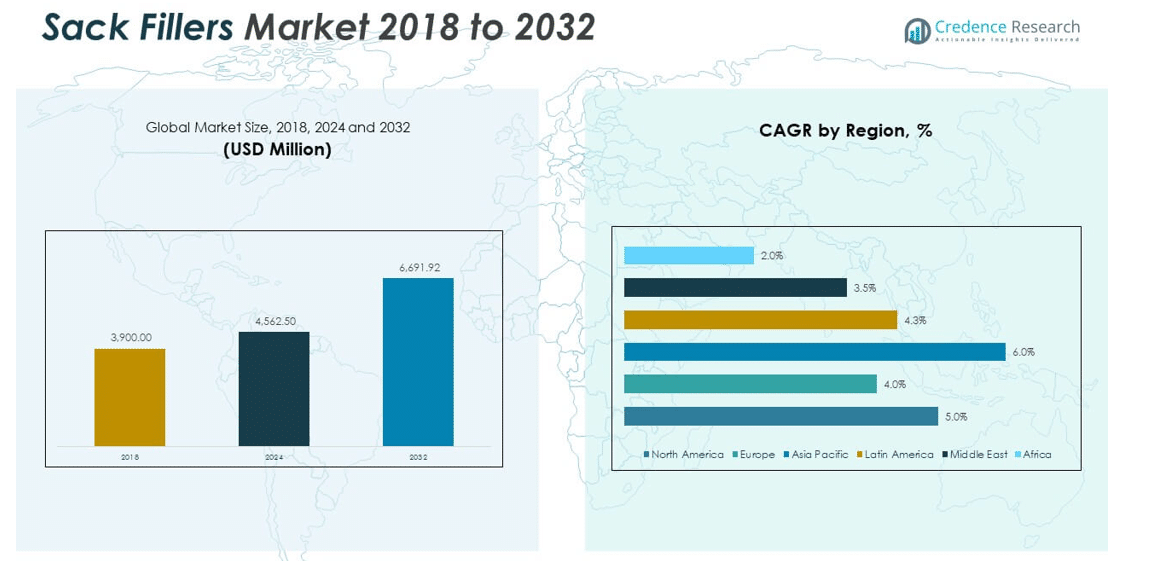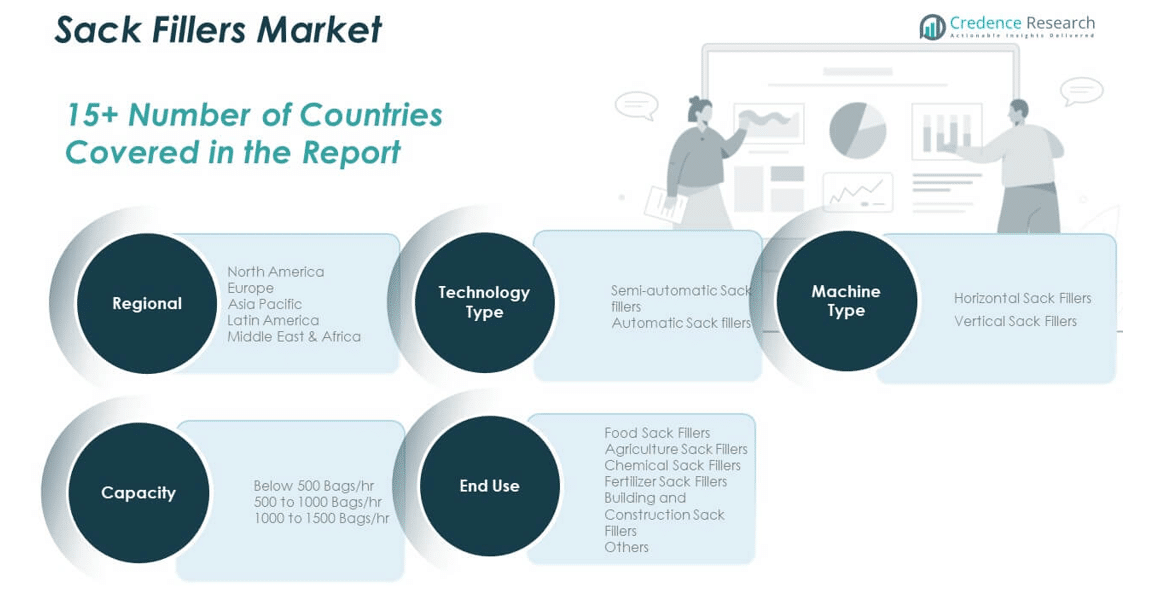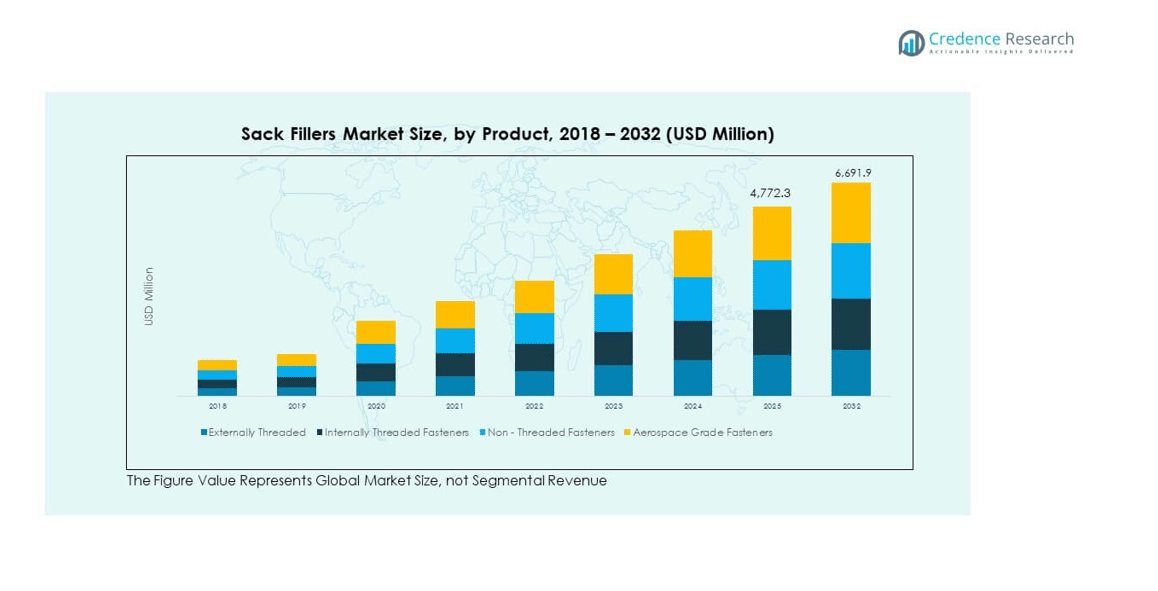CHAPTER NO. 1 : GENESIS OF THE MARKET
1.1 Market Prelude – Introduction & Scope
1.2 The Big Picture – Objectives & Vision
1.3 Strategic Edge – Unique Value Proposition
1.4 Stakeholder Compass – Key Beneficiaries
CHAPTER NO. 2 : EXECUTIVE LENS
2.1 Pulse of the Industry – Market Snapshot
2.2 Growth Arc – Revenue Projections (USD Million)
2.3. Premium Insights – Based on Primary Interviews
CHAPTER NO. 3 : SACK FILLERS MARKET FORCES & INDUSTRY PULSE
3.1 Foundations of Change – Market Overview
3.2 Catalysts of Expansion – Key Market Drivers
3.2.1 Momentum Boosters – Growth Triggers
3.2.2 Innovation Fuel – Disruptive Technologies
3.3 Headwinds & Crosswinds – Market Restraints
3.3.1 Regulatory Tides – Compliance Challenges
3.3.2 Economic Frictions – Inflationary Pressures
3.4 Untapped Horizons – Growth Potential & Opportunities
3.5 Strategic Navigation – Industry Frameworks
3.5.1 Market Equilibrium – Porter’s Five Forces
3.5.2 Ecosystem Dynamics – Value Chain Analysis
3.5.3 Macro Forces – PESTEL Breakdown
3.6 Price Trend Analysis
3.6.1 Regional Price Trend
3.6.2 Price Trend by product
CHAPTER NO. 4 : KEY INVESTMENT EPICENTER
4.1 Regional Goldmines – High-Growth Geographies
4.2 Product Frontiers – Lucrative Product Categories
4.3 Capacity Sweet Spots – Emerging Demand Segments
CHAPTER NO. 5: REVENUE TRAJECTORY & WEALTH MAPPING
5.1 Momentum Metrics – Forecast & Growth Curves
5.2 Regional Revenue Footprint – Market Share Insights
5.3 Segmental Wealth Flow – Machine Type & Capacity Revenue
CHAPTER NO. 6 : TRADE & COMMERCE ANALYSIS
6.1. Import Analysis by Region
6.1.1. Global Sack Fillers Market Import Revenue By Region
6.2. Export Analysis by Region
6.2.1. Global Sack Fillers Market Export Revenue By Region
CHAPTER NO. 7 : COMPETITION ANALYSIS
7.1. Company Market Share Analysis
7.1.1. Global Sack Fillers Market: Company Market Share
7.2. Global Sack Fillers Market Company Revenue Market Share
7.3. Strategic Developments
7.3.1. Acquisitions & Mergers
7.3.2. New Product Launch
7.3.3. Regional Expansion
7.4. Competitive Dashboard
7.5. Company Assessment Metrics, 2024
CHAPTER NO. 8 : SACK FILLERS MARKET – BY MACHINE TYPE SEGMENT ANALYSIS
8.1. Sack Fillers Market Overview by Machine Type Segment
8.1.1. Sack Fillers Market Revenue Share By Machine Type
8.2. Horizontal Sack Fillers
8.3. Vertical Sack Fillers
CHAPTER NO. 9 : SACK FILLERS MARKET – BY CAPACITY SEGMENT ANALYSIS
9.1. Sack Fillers Market Overview by Capacity Segment
9.1.1. Sack Fillers Market Revenue Share By Capacity
9.2. Below 500 Bags/hr
9.3. 500 to 1000 Bags/hr
9.4. 1000 to 1500 Bags/hr
CHAPTER NO. 10 : SACK FILLERS MARKET – BY END-USE SEGMENT ANALYSIS
10.1. Sack Fillers Market Overview by End-use Segment
10.1.1. Sack Fillers Market Revenue Share By End-use
10.2. Food Sack Fillers
10.3. Agriculture Sack Fillers
10.4. Chemical Sack Fillers
10.5. Fertilizer Sack Fillers
10.6. Building and Construction Sack Fillers
10.7. Others
CHAPTER NO. 11 : Sack Fillers MARKET – BY TECHNOLOGY TYPE SEGMENT ANALYSIS
11.1. Sack Fillers Market Overview by Technology Type Segment
11.1.1. Sack Fillers Market Revenue Share By Technology Type
11.2. Semi-automatic Sack fillers
11.3. Automatic Sack fillers
CHAPTER NO. 12 : SACK FILLERS MARKET – REGIONAL ANALYSIS
12.1. Sack Fillers Market Overview by Region Segment
12.1.1. Global Sack Fillers Market Revenue Share By Region
12.1.2. Regions
12.1.3. Global Sack Fillers Market Revenue By Region
12.1.4. Machine Type
12.1.5. Global Sack Fillers Market Revenue By Machine Type
12.1.6. Capacity
12.1.7. Global Sack Fillers Market Revenue By Capacity
12.1.8. End-use
12.1.9. Global Sack Fillers Market Revenue By End-use
12.1.10. Technology Type
12.1.11. Global Sack Fillers Market Revenue By Technology Type
CHAPTER NO. 13 : NORTH AMERICA SACK FILLERS MARKET – COUNTRY ANALYSIS
13.1. North America Sack Fillers Market Overview by Country Segment
13.1.1. North America Sack Fillers Market Revenue Share By Region
13.2. North America
13.2.1. North America Sack Fillers Market Revenue By Country
13.2.2. Machine Type
13.2.3. North America Sack Fillers Market Revenue By Machine Type
13.2.4. Capacity
13.2.5. North America Sack Fillers Market Revenue By Capacity
13.2.6. End-use
13.2.7. North America Sack Fillers Market Revenue By End-use
13.2.8. Technology Type
13.2.9. North America Sack Fillers Market Revenue By Technology Type
13.3. U.S.
13.4. Canada
13.5. Mexico
CHAPTER NO. 14 : EUROPE SACK FILLERS MARKET – COUNTRY ANALYSIS
14.1. Europe Sack Fillers Market Overview by Country Segment
14.1.1. Europe Sack Fillers Market Revenue Share By Region
14.2. Europe
14.2.1. Europe Sack Fillers Market Revenue By Country
14.2.2. Machine Type
14.2.3. Europe Sack Fillers Market Revenue By Machine Type
14.2.4. Capacity
14.2.5. Europe Sack Fillers Market Revenue By Capacity
14.2.6. End-use
14.2.7. Europe Sack Fillers Market Revenue By End-use
14.2.8. Technology Type
14.2.9. Europe Sack Fillers Market Revenue By Technology Type
14.3. UK
14.4. France
14.5. Germany
14.6. Italy
14.7. Spain
14.8. Russia
14.9. Rest of Europe
CHAPTER NO. 15 : ASIA PACIFIC SACK FILLERS MARKET – COUNTRY ANALYSIS
15.1. Asia Pacific Sack Fillers Market Overview by Country Segment
15.1.1. Asia Pacific Sack Fillers Market Revenue Share By Region
15.2. Asia Pacific
15.2.1. Asia Pacific Sack Fillers Market Revenue By Country
15.2.2. Machine Type
15.2.3. Asia Pacific Sack Fillers Market Revenue By Machine Type
15.2.4. Capacity
15.2.5. Asia Pacific Sack Fillers Market Revenue By Capacity
15.2.6. End-use
15.2.7. Asia Pacific Sack Fillers Market Revenue By End-use
15.2.8. Technology Type
15.2.9. Asia Pacific Sack Fillers Market Revenue By Technology Type
15.3. China
15.4. Japan
15.5. South Korea
15.6. India
15.7. Australia
15.8. Southeast Asia
15.9. Rest of Asia Pacific
CHAPTER NO. 16 : LATIN AMERICA SACK FILLERS MARKET – COUNTRY ANALYSIS
16.1. Latin America Sack Fillers Market Overview by Country Segment
16.1.1. Latin America Sack Fillers Market Revenue Share By Region
16.2. Latin America
16.2.1. Latin America Sack Fillers Market Revenue By Country
16.2.2. Machine Type
16.2.3. Latin America Sack Fillers Market Revenue By Machine Type
16.2.4. Capacity
16.2.5. Latin America Sack Fillers Market Revenue By Capacity
16.2.6. End-use
16.2.7. Latin America Sack Fillers Market Revenue By End-use
16.2.8. Technology Type
16.2.9. Latin America Sack Fillers Market Revenue By Technology Type
16.3. Brazil
16.4. Argentina
16.5. Rest of Latin America
CHAPTER NO. 17 : MIDDLE EAST SACK FILLERS MARKET – COUNTRY ANALYSIS
17.1. Middle East Sack Fillers Market Overview by Country Segment
17.1.1. Middle East Sack Fillers Market Revenue Share By Region
17.2. Middle East
17.2.1. Middle East Sack Fillers Market Revenue By Country
17.2.2. Machine Type
17.2.3. Middle East Sack Fillers Market Revenue By Machine Type
17.2.4. Capacity
17.2.5. Middle East Sack Fillers Market Revenue By Capacity
17.2.6. End-use
17.2.7. Middle East Sack Fillers Market Revenue By End-use
17.2.8. Technology Type
17.2.9. Middle East Sack Fillers Market Revenue By Technology Type
17.3. GCC Countries
17.4. Israel
17.5. Turkey
17.6. Rest of Middle East
CHAPTER NO. 18 : AFRICA SACK FILLERS MARKET – COUNTRY ANALYSIS
18.1. Africa Sack Fillers Market Overview by Country Segment
18.1.1. Africa Sack Fillers Market Revenue Share By Region
18.2. Africa
18.2.1. Africa Sack Fillers Market Revenue By Country
18.2.2. Machine Type
18.2.3. Africa Sack Fillers Market Revenue By Machine Type
18.2.4. Capacity
18.2.5. Africa Sack Fillers Market Revenue By Capacity
18.2.6. End-use
18.2.7. Africa Sack Fillers Market Revenue By End-use
18.2.8. Technology Type
18.2.9. Africa Sack Fillers Market Revenue By Technology Type
18.3. South Africa
18.4. Egypt
18.5. Rest of Africa
CHAPTER NO. 19 : COMPANY PROFILES
19.1. Haver & Boecker Company
19.1.1. Company Overview
19.1.2. Product Portfolio
19.1.3. Financial Overview
19.1.4. Recent Developments
19.1.5. Growth Strategy
19.1.6. SWOT Analysis
19.2. Webster Griffin Ltd.
19.3. All-Fill Incorporated
19.4. CONCETTI S.P.A.
19.5. Fres-co System USA Inc.
19.6. WOLF Verpackungsmachinen GmbH
19.7. Barry-Wehmiller Companies
19.8. Imanpack Packaging
19.9. STATEC BINDER GmbH
19.10. HASSIA-REDATRON GmbH
19.11. Premier Tech Chronos
19.12. MONDIAL PACK S.r.l.
19.13. Robert Bosch Packaging Technology GmbH
19.14. Inpak System Inc.










